Study Counters Many Theories on Underclass : Poverty: Teen-age pregnancy rates have fallen since the 1960s. Concept of welfare dependency is disputed.
- Share via
WASHINGTON — The impoverished underclass of the nation’s cities is smaller than many had thought but its problems may be more intractable than both conservative and liberal theorists believe, according to one of the most extensive studies ever on underclass poverty.
The research, to be released today by Washington’s Brookings Institution, contradicts many common notions about urban poverty and rebuts arguments on the subject of both liberal and conservative politicians.
For example, despite extensive publicity about an “epidemic” of teen-age pregnancy, pregnancy rates among teen-agers have declined sharply, falling by about one-third from the mid-1960s until the late 1980s, the research shows.
Births to teen-agers dropped sharply during the mid-1960s as contraceptive pills became more widespread, then dropped again after abortions became more widely available during the mid-1970s. The rates have continued to decline slowly ever since with black teen-age pregnancy rates remaining higher than whites but declining faster.
In 1960, a random sample of 100 black teen-age girls could be expected to have 80 babies by the time they all turned 20. For white girls, the number would have been 40 per 100. By 1986, the number had dropped to 51 for blacks and 21 for whites. Similarly, both violent crime and urban high school dropout rates improved notably during the 1980s, a sharp contradiction of a widespread popular belief. The perception that urban schools are failing “may reflect a revolution of rising expectations” more than any real change in school performance, writes Christopher Jencks of Northwestern University, one of the new study’s principal authors.
Crime has worsened for some parts of the population--particularly young, black men, who appear often as victims or perpetrators of offenses--but fell for most people over the last decade.
At the same time, the money that young men are able to earn fell sharply, particularly the earnings of minority men and those who did not finish college. And the collapse of traditional family structures both in poor neighborhoods and elsewhere has spread rapidly, worsening the problems faced by the growing number of low-income, single-parent families.
Although the research contained in the study was conducted primarily by scholars with a liberal orientation, the work drew praise from a prominent conservative researcher and the findings are likely to upset some cherished liberal notions.
Most important, several of the research studies contained in the new volume emphasize the importance of individual behavior in determining who stays poor and who does not, rebutting the argument that virtually all the problems of poverty can be traced to a decline in the number of “good” jobs.
A major factor, the research shows, appears to be an overall decline in traditional family structures which has hit both poor and non-poor neighborhoods. “The most powerful force contributing to the formation of an urban underclass, perversely enough, may be the changing values of mainstream American society,” writes one of the study’s principal authors, Paul E. Peterson of Harvard University.
At the same time, however, the new research disputes a prominent conservative argument that welfare benefits have underpinned a “culture of poverty” that disdains work.
To the contrary, the study’s authors emphasize, poverty spread during the 1980s even as welfare benefits fell sharply. Contrary to the conservative argument that low-income women often can profit by having children and going on welfare rather than working, the new study demonstrates that the disincentives to such behavior are large.
Moreover, in areas such as Boston and Anaheim which had low unemployment during the 1980s, low-income people readily left welfare even for relatively low-wage jobs and poverty fell rapidly, according to studies of labor markets contained in the new volume.
The research also emphasizes the continued impact that racial discrimination plays in keeping low-income blacks out of jobs.
The new study is “extremely valuable,” said Charles Murray of Washington’s American Enterprise Institute, a conservative whose 1984 book, “Losing Ground,” argued that the expansion of the welfare state during the Lyndon B. Johnson and Richard M. Nixon administrations had worsened poverty by allowing people to become dependent on welfare.
From the end of the 1960s until recently, research into poverty and the lives of poor people has been unfashionable in academia. As a result, said Murray, “there have been a lot of statements on the underclass based on very little data.”
The new volume is a collection of 19 studies and essays that examine a range of sourcesto draw its conclusions about the size and shape of underclass poverty.
The degree to which politicians now see poverty as an urban and a minority issue has helped deadlock government efforts to address poverty issues, in the view of many political analysts. The political perception is considerably different from reality, at least on racial issues. Blacks made up slightly less than one-third of the impoverished population a generation ago and continue to make up roughly the same percentage in the latest census studies.
Whether poverty is rising or falling among Latinos remains unclear because of the effect of immigration and the changing ways the census counts that part of the population.
Overall, poverty in America improved rapidly from the end of World War II through the early 1970s. But with the economic stagnation that followed the sharp increase in oil prices in 1973, that progress abruptly stopped. Since then, the proportion of the population falling below the poverty line has remained roughly the same, about 13%, rising slightly during recession periods and falling somewhat during better economic times.
More to Read
Sign up for Essential California
The most important California stories and recommendations in your inbox every morning.
You may occasionally receive promotional content from the Los Angeles Times.














